Updated: 10 October 2024
Quick Takeaways:
- Decking Decisions: Choosing between timber and composite decking hinges on aesthetics, long-term costs, and maintenance needs.
- Investment Insights: Initial costs for may be lower for wooden decks, but composite decking often presents greater value over time due to its minimal maintenance requirements.
- Eco-Friendly Factors: While timber naturally decomposes, composite materials highlight sustainable recycling practices, offering an environmentally-conscious alternative.
Timber and composite materials are the two most popular decking choices for an attractive, long-lasting deck. But, which is better for homeowners in Australia?
In this blog post, we’ll guide you in comparing the pros and cons of each option to determine the best fit for your needs.
Timber decking is the old standby, with planks made from hardwood. Popular Australian lumber species include Jarrah, Blackbutt, and Spotted Gum. The best hardwood material depends on:
- Climate conditions in your location
- Use – is there heavy furniture? High foot traffic? A pool?
- Level of UV and weather exposure
Some types of wood are more prone to fading and weathering than others, so this choice matters when it comes to choosing suitable materials to withstand the test of time.
Composite decking, however, combines repurposed hardwood with recycled plastic. These materials are mixed and held together using a binding agent to make incredibly strong decking boards.
Because of the combination, composite decking is able to be supplied in a variety of colours. And, since the materials are weather-resistant, factors such as placement and local climate are less important if you select composite decking.
There’s also more options in composites for BAL areas – meaning you don’t have to give up on outdoor living just because you cannot build a timber deck according to your area’s regulations.
Here’s a before and after photo showing weather damage to existing decking that has not been cared for, and replacement composite boards that require very little maintenance whatsoever:
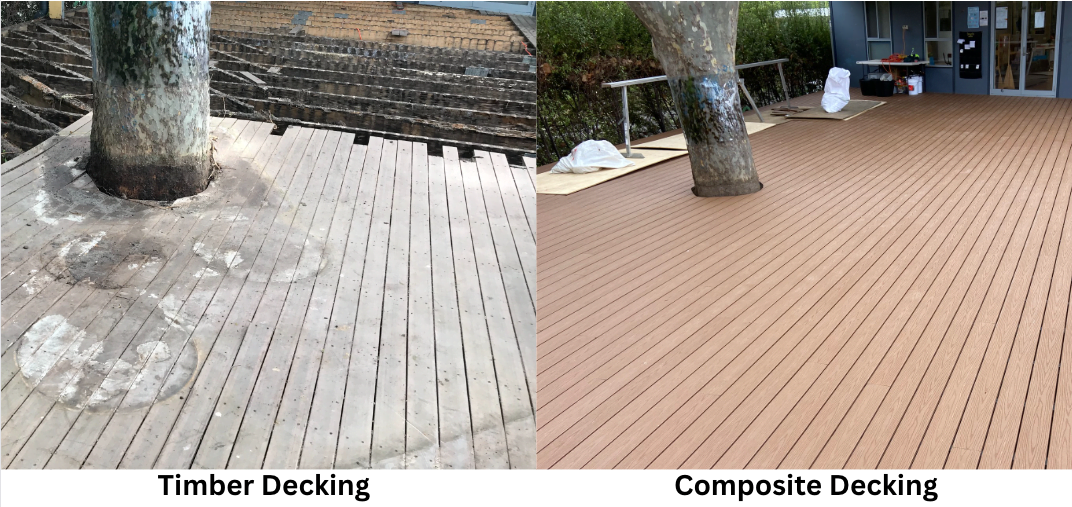
Related: What is Composite Decking?
Differences in Appearance
Timber Decking
Traditional wood decking has a natural appearance. You can use oils or other treatments to alter the colour tone of the deck surface. However, you must reapply the treatment every year to maintain that colour.
Wooden decking typically turns grey if allowed to age without additional treatment (you can see this clearly in the before and after photo above).
Composite Decking Boards
Composite decking offers a broader range of design choices. Some products are textured, while others have colours and patterns resembling natural wood. Unlike timber, capped composite decking does not turn grey over time. This is particularly obvious in warm toned woods like spotted gum, which go silvery in time while our premium spotted gum composite decking remains as good as new.
Composite decking has come a very long way since it first appeared on the Australian market. Premium composite brands like NexGEN are specifically designed to balance performance with appearance, making them almost indistinguishable from ‘the real thing’.
Here are some of our most popular colours that offer a warm appeal and mimic various hardwood species, so you can achieve the look minus the common issues from using timber:
| Spotted Gum | Jarrah | Blackbutt |
|---|---|---|
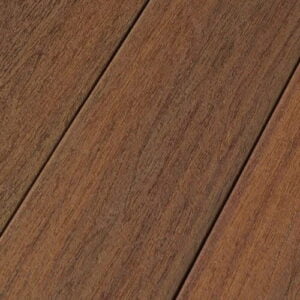 |
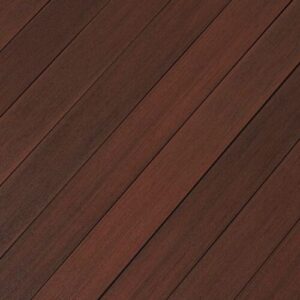 |
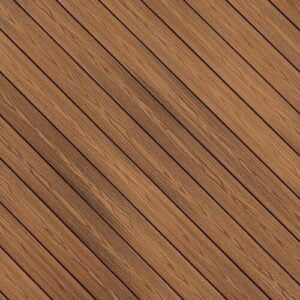 |
| Graphite | White Oak | Multi-chromatic |
 |
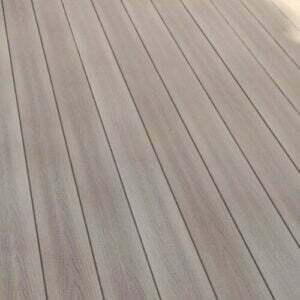 |
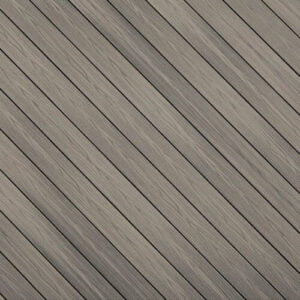 |
Click the following link to see complete range of NEXGEN composite timber decking.
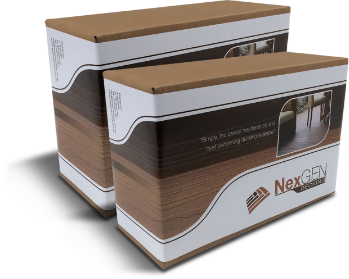
DO YOU WANT A
FREE SAMPLE PACK?
Can’t decide on a colour?
Fill out the form, and we’ll Express Post your free decking samples to you ASAP!
LET’S GET STARTED
ON YOUR PROJECT
Contact us to kick things off. This will be more fun than you think!
Differences in cost: Hardwood vs composite decking
You can compare composite decking versus wood costs in two ways: considering the initial price or the lifetime cost. Composite decking is slightly more expensive upfront. Composite materials are $350 to $500 per square metre. Wooden decking, say treated pine, comes in at $220 to $260 per square metre.
Estimate the costs of your decking project with our free composite decking price tool
However, hardwood requires additional investments in oil or stain every year. Sanding down splinters and other steps can also add to your overall ownership costs. When you consider these extra maintenance costs, capped composite products are the cheaper option over their lifetime.
The graphic below shows a comparison of the total cost of ownership per year for traditional wood versus composite decking:
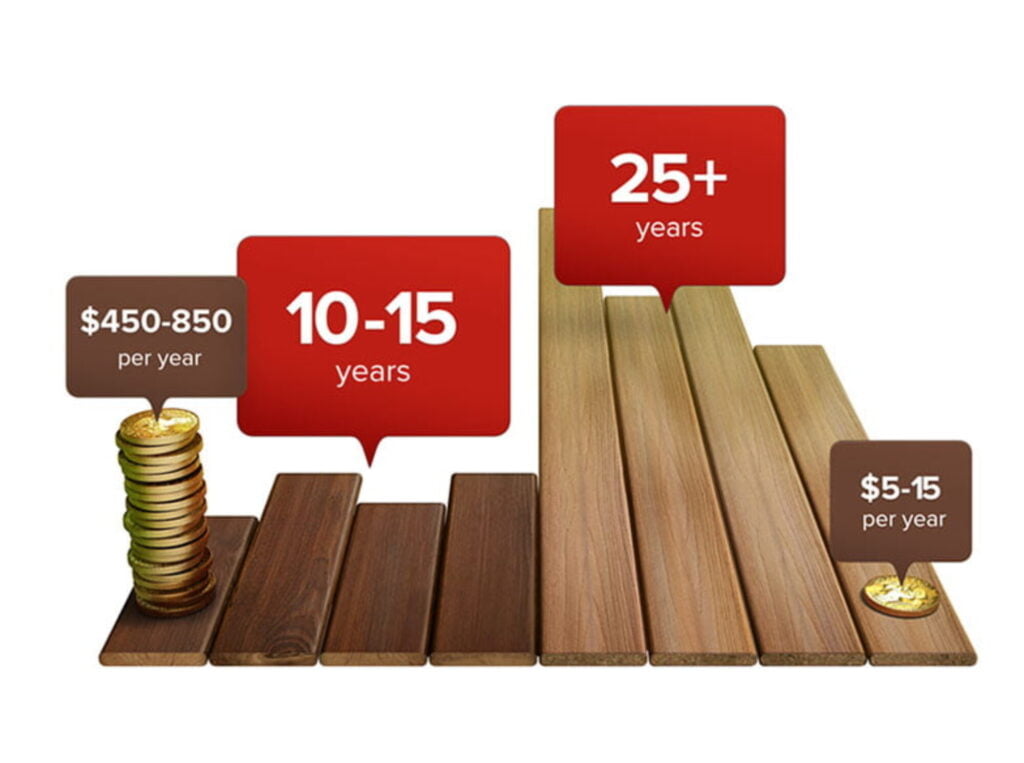

Hardwood decking costs at least $450 per year while maintaining capped composite boards can cost as little as $5 annually.
You can clearly see the financial advantages of composite decking versus the upkeep and labour costs of wood.
Related: Why You Can’t Afford to Buy Cheap Composite Decking.
Differences in installation: Which is easier?
Composite decking boards are a fully engineered product, which simplifies and speeds up the installation process. Boards can be cut but often don’t need it for standard shapes of decking. The supporting structure (subframes, joists, etc.) are also pre-fabricated for quick assembly and installation.
By contrast, the installer will likely need to cut timbers onsite when building the deck. It’s a messier process and often takes longer, requiring more specialised knowledge (whereas NexGEN products are manufactured for easy DIY if you so choose).
Installation requirements for both types of decking will vary depending on the structure, the supports, and extras like a waterproof drainage system such as NexGEN’s DryJoist system.
If you’re a keen DIY enthusiast, watch our YouTube explainer video on how to build a deck using NexGEN’s DIY DeckCell technology:
Maintaining your decking
As previously mentioned, composite decking requires very little maintenance even in the harshest Australian conditions.
You don’t have to worry about painting, staining, or oiling a capped composite deck to ensure its natural beauty. These jobs are necessary with wood to maintain the natural colour and increase longevity.
The graphic below illustrates the stark difference in time commitment for real wood vs hardwood filled composite decking to enjoy a beautiful deck:
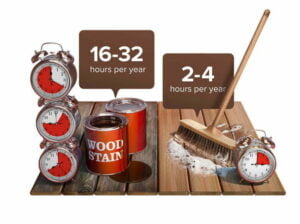

Extrapolate this out by 20 or 30 years, and consider how else you could be spending that time…
The amount of maintenance needed for standard wooden decking depends on two factors: sun exposure and usage. UV rays dull the natural appearance of the wood, leading to the flat grey colour so common in older decks.
Since composite decking boards are not affected by fading from UV rays, it does not need this type of maintenance.
Hardwood decking can crack and form splinters with heavy use or exposure to harsh weather. On the flip side, composite decking gives you the comfort of walking on a deck barefoot without the worry of painful splinters.
Oiling or staining regularly can help retain moisture in wooden materials, and sanding may be necessary to remove potentially harmful splinters and snags.
How long will your decking last?
The longevity of natural timbers depends on proper maintenance. Heavily used decking exposed to excessive sunlight, moisture, or temperature changes will need extensive maintenance, including sealing and sanding.
Composite decks might require repairs or replacement of some boards over their lifespan, but they do not need the same level of ongoing care and sealing to stay in their best condition.
Plus, composite decking made from higher-quality composite materials often comes with lengthy warranties of up to 30 years for Australian customers.
NexGEN’s flagship range of Select capped composite decking boards has the industry’s first 50-year fade and stain warranty and lifetime performance guarantee. This means you’re protected against checking, splintering, delamination, warping, rot and structural damage from fungal decay.
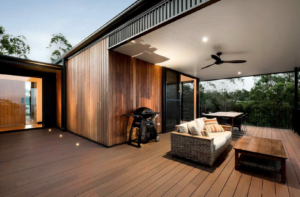

View the Select range of capped composites now
Our warranties and guarantees are why we’re one of the leading composite decking brands on the Australian market.
Not all composite materials are created equal. Be sure you’ve done your research before deciding on a supplier.
Want some free samples of our composite deck boards? Simply write us an email telling us about your project, and we’ll send you a box by Express Post.
Convenience and livability
Both decking types offer user-friendly features.
The surface of traditional wood decking remains relatively cool when exposed to direct sunlight. However, it can become slippery when wet.
Composite decking manages moisture more effectively and often features a slip-resistant texture, making it safer in wet conditions like around your pool area. It also stays cooler underfoot, perfect for hot Australian days.
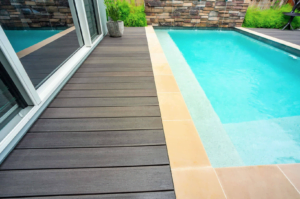

For more information about pool decking, see Composite Decking for Pool Surroundings.
The danger of moisture to traditional decks
Speaking of moisture; wooden boards are a natural target for mould and other fungi. Quality composite decking is mould-resistant.
Mould removal can be complicated, and the unwanted fungi can expose you, your family, pets, and guests to potential health issues. This risk is especially dire for people with mould sensitivities.
What about insect damage?
A wood deck is a primary target for pests. Termites pose a significant threat to it. These pests can eat several times their body weight in the wood daily, and a swarm can quickly damage the structural integrity. If left untreated, an infestation could damage a conventional deck beyond repair.
Termites are not attracted to the wood fibre and plastic mixture in composite decking, so this material is the obvious choice in areas prone to termite infestations.
Environmental footprint
The environmental impact of a new deck depends on different factors. Timber is biodegradable, but often forestry takes a toll on local ecosystems. For example, popular timbers like Merbau are prized for their relative durability as a hardwood, but have historically been harvested in questionably ethical and environmentally sound circumstances.
Sustainable sourcing can lower environmental impact. However, the location of the materials also matters.
Natural timber or composite decking shipped from far away will produce more carbon emissions than products purchased from a local or regional company.
In contrast, composite boards can be recycled, showcasing them as a renewable resource.
Composite decking products use recycled wood, plastic and other reclaimed materials during manufacturing, lowering the overall environmental impact – making them a more environmentally friendly choice.
The graphic below illustrates composite vs natural lumber decking in terms of pest control requirements and the use of recycled plastic:
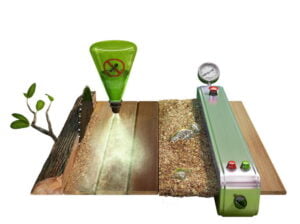

Which decking product is right for you?
Those seeking a rustic or natural look will often opt for timber, which also provides a cheaper price for people looking to reduce upfront costs.
However, in our view, capped composite is the better choice of decking material because it provides all the best benefits: Convenience, low maintenance, lower total cost of ownership, and longevity.
Simply put, composite decking gives you all the desired aesthetics of timber without the costs and regular maintenance.
Here’s a quick summary:
- Material Differences: Timber offers a natural look and is cost-effective upfront, but may require more maintenance over time. Composite decking, a blend of wood and plastic, provides durability, and various design choices, and demands less regular upkeep.
- Long-Term Costs: While timber has lower initial costs, long-term maintenance can make it more expensive than composite decking, which may offer better value over its lifespan due to low maintenance needs.
- Environmental Considerations: Timber is biodegradable but may have sourcing concerns, while composite decking uses recycled materials, making it a more environmentally-friendly choice depending on manufacturing and shipping practices.
What are the next steps?
If you are looking for the best composite decking in Australia, consider NexGEN Decking. We use Fiberon composites, which are made in North America and come in different styles, colours, and textures.
And while our composite decking prices are higher than some of our competitors, our products inspire confidence with a warranty of up to 50 years for residential customers.
NexGEN Decking has offices in Melbourne, Sydney, Perth, Brisbane, and Adelaide and we deliver our products right across Australia.
Why not reach out to us today and learn more about our high-quality capped composite decking?




DO YOU WANT A
FREE SAMPLE PACK?
Can’t decide on a colour?
Fill out the form, and we’ll Express Post your free decking samples to you ASAP!
LET’S GET STARTED
ON YOUR PROJECT
Contact us to kick things off. This will be more fun than you think!
Products
Gallery
Contact
Direct Office Numbers
Adelaide – (08) 6316 0469
Brisbane – (07) 3041 6065
Melbourne – (03) 8672 6444
Sydney – (02) 8072 6220
